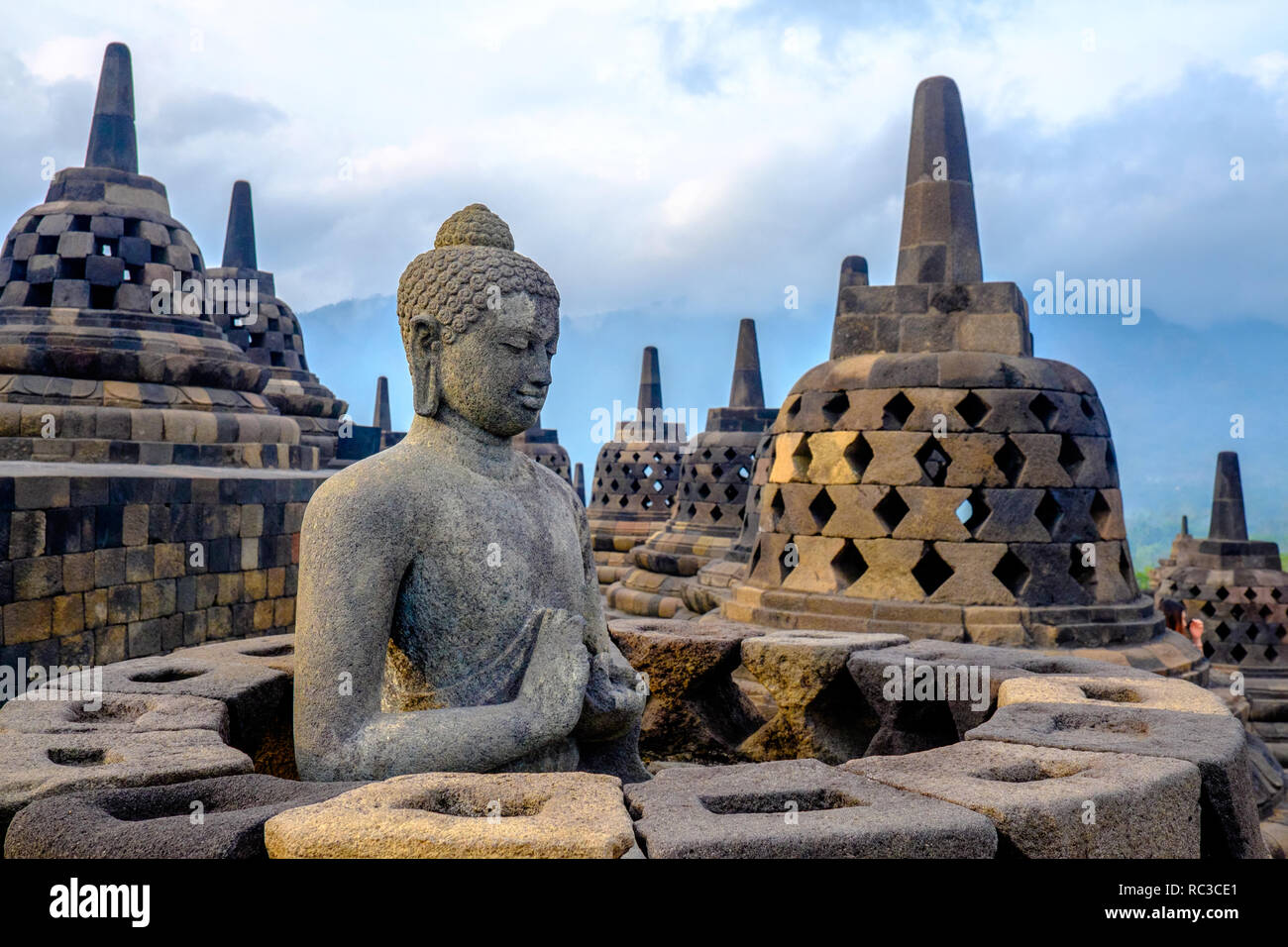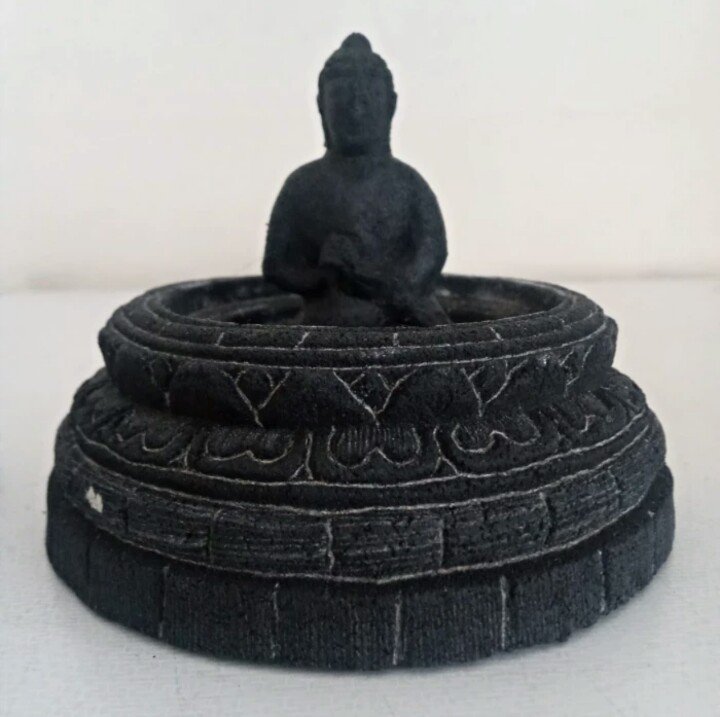Introduction: A Whispered Secret in Stone
Imagine standing atop an ancient pyramid, the mist still clinging to distant volcanic peaks, as the first rays of dawn paint the sky in hues of gold and rose. Below you, and around you, stretching into the mystical haze, are hundreds of intricately carved stone stupas. These aren’t just solid domes; many are latticed, like giant, stone baskets, each cradling a serene Buddha statue within. This is the magic of Borobudur, and specifically, the awe-inspiring experience of exploring its upper terraces, where the Borobudur temple miniature stupas stand guard, silently narrating tales of enlightenment and devotion. It’s a destination that promises not just sights, but profound insights, leaving an indelible mark on every traveler’s heart.
Highlights: Where History Meets Heavenly Views
The atmosphere at Borobudur, particularly among the miniature stupas, is one of profound tranquility and timeless wonder. As you ascend the nine levels, moving from the earthly realm of carved reliefs depicting human life towards the spiritual realm of the circular terraces, the energy shifts. Here, amidst the 72 bell-shaped stupas on the upper three circular platforms, a sense of peace descends. The natural scenery is breathtaking: lush, tropical plains stretch out to meet the horizon, punctuated by the majestic silhouettes of volcanoes like Merapi and Merbabu. On a clear morning, these giants seem to watch over Borobudur, adding to its mystical aura.
Culturally, these miniature stupas are a marvel of 9th-century Buddhist architecture. Each latticed stupa, whether diamond-shaped or square, conceals a Dhyani Buddha statue in a specific mudra (hand gesture), corresponding to its direction and spiritual meaning. The sheer detail in the stone carving, enduring over a millennium, is astonishing. You can peer through the openings, catching a glimpse of the Buddha within, and feel a tangible connection to the ancient artisans who poured their devotion into every chisel stroke. This is not just a monument; it’s a living testament to human faith and artistic genius, a pilgrimage site that still resonates with spiritual energy today.

Activities: Engaging with the Ancient
Your journey through Borobudur is an active exploration. Begin by arriving well before sunrise. The Borobudur temple miniature stupas bathed in the first light of day is an unparalleled spectacle, offering incredible photo opportunities and a deeply spiritual experience. Walk slowly, tracing the path of circumambulation, feeling the cool stone beneath your bare feet (often required in certain areas as a sign of respect). Each level, each corner, reveals a new perspective of these exquisite structures. Try to find the single open stupa that allows you to fully touch the Buddha inside – a moment of unique connection.
Beyond photography and quiet contemplation, consider hiring a local guide. Their insights into the Buddhist cosmology, the stories depicted on the reliefs leading up to the stupas, and the architectural nuances will enrich your understanding immensely. Spend time simply sitting among the stupas, absorbing the silence and the expansive views. It’s an ideal spot for meditation or simply reflecting on the grandeur of human achievement and the profound peace that can be found in such a sacred space.
Travel Tips: Your Journey to Enlightenment
- Best Time to Visit: The dry season (May to September) offers the most pleasant weather. For the ultimate experience, aim for a sunrise visit. While it requires an early start (often 4:00 AM), the cooler temperatures, fewer crowds, and ethereal light make it absolutely worth it.
- How to Get There: The nearest major airport is Yogyakarta International Airport (YIA). From Yogyakarta city, Borobudur is about a 1.5-hour drive. You can arrange private car hire, join a tour bus, or use ride-sharing apps. Many hotels in Yogyakarta also offer shuttle services.
- Entrance Fees: There are separate entrance fees for foreigners and local visitors. Sunrise entry often requires a special, more expensive ticket, usually purchased from the Manohara Hotel within the complex, which grants early access before general opening hours. Always check the latest prices online before your visit.
- Nearby Attractions: Combine your trip to Borobudur with a visit to the equally stunning Prambanan Temple complex (a Hindu UNESCO site), forming a powerful duo of ancient Indonesian religious architecture. Don’t miss the smaller, yet significant, Mendut and Pawon temples, which are part of the Borobudur pilgrimage route. For another incredible sunrise view over Borobudur, consider Punthuk Setumbu Hill.
- Local Food Specialties: In the surrounding area, and especially in nearby Yogyakarta, indulge in local delicacies. Try "Gudeg," a sweet jackfruit stew, "Sate Klathak" (skewered lamb grilled over charcoal), or "Bakpia Pathok," sweet bean-filled pastries perfect for a snack or souvenir.
- Unique Souvenirs: You’ll find charming replicas of the Borobudur stupas, Buddha statues, and intricate batik fabrics. Local artisans also offer beautiful silver jewelry and traditional wooden crafts, providing authentic mementos of your unforgettable journey.
Conclusion: A Timeless Invitation
The Borobudur temple miniature stupas are more than just architectural elements; they are silent storytellers, guardians of wisdom, and beacons of tranquility. To walk among them, to glimpse the Buddhas within, and to witness the dawn break over this ancient wonder is to experience a connection to history, spirituality, and breathtaking beauty that few places on Earth can offer. It’s a journey that stimulates the senses, calms the mind, and invigorates the soul. So, pack your bags, prepare your cameras, and open your heart – Borobudur is calling, promising an adventure that will resonate long after you’ve returned home. Isn’t it time you answered?


